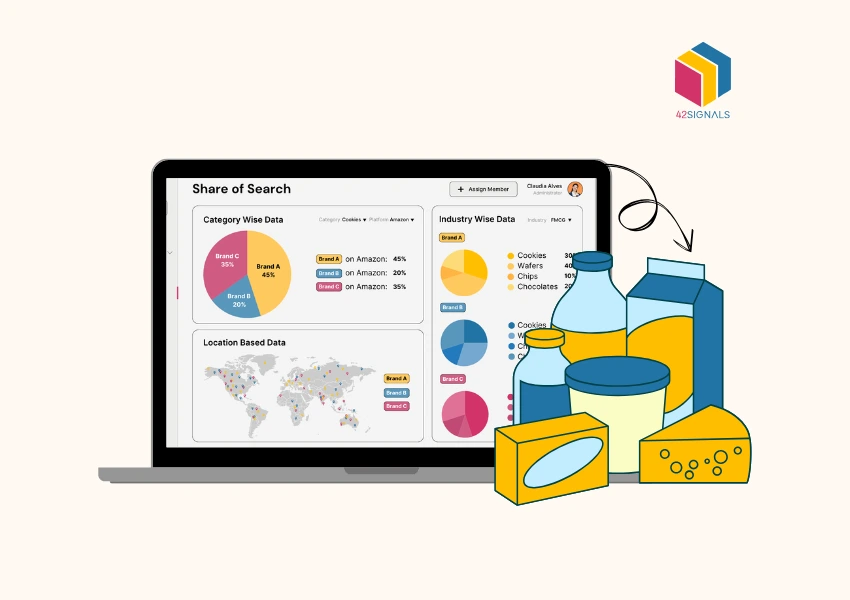To capitalize on market share and increase sales, companies constantly strive to expand their product lines to capture more market share, meet diverse consumer needs, and boost revenues. However, in this aggressive pursuit of growth, companies often encounter a phenomenon known as “product cannibalization.”
This concept, while not inherently negative, poses significant challenges if not strategically managed. Let’s understand the intricacies of product cannibalization, its implications, and the role of competitor monitoring, price monitoring, and other key strategies to mitigate its effects.
What is Product Cannibalization?
Product cannibalization occurs when a company’s new product eats into the sales of one of its existing products, rather than expanding the company’s overall market share. Essentially, instead of attracting new customers or creating new revenue streams, the new product merely shifts the existing revenue from one product to another within the same company.
This can be particularly problematic if the new product is less profitable or if it undermines the market position of the older product without bringing in additional market share. For example, consider a smartphone company that launches a new model with similar features to its existing model but at a lower price, like the iPhone SE.

Image Source: MacRumors
If the customers who would have purchased the older, higher-priced model now opt for the new one, the company may not see the overall revenue increase it anticipated. Instead, it may simply redistribute its revenue, or worse, experience a drop in profitability due to the lower price point of the new model.
What Causes Product Cannibalization?
Several factors can contribute to product cannibalization:

Image Source: Chisel Labs
- Product Line Expansion: Companies often expand their product lines to offer more options to consumers. However, if these new products are too similar to existing ones, they may end up competing against each other.
- Pricing Strategies: Introducing a new product at a lower price point can attract price-sensitive customers, leading to a shift from higher-priced items to the new, cheaper alternative. Without careful price monitoring, companies can inadvertently erode their profits.
- Overlapping Target Markets: When a new product targets the same market segment as an existing product, it can result in cannibalization. This often happens when companies fail to differentiate the new product sufficiently or when the perceived value of the new product overshadows the old one.
- Inadequate Market Research: Launching a new product without thorough market research can lead to cannibalization. Understanding consumer needs and preferences is crucial in ensuring that new products complement, rather than compete with, existing offerings.
How Product Cannibalization is Impacting the SaaS Industry?
Cannibalization is not limited to physical goods; it is a significant concern in the Software as a Service (SaaS) industry as well. SaaS companies, known for their innovation and frequent product updates, are particularly susceptible to this phenomenon. The fast-paced nature of the SaaS market, combined with the need to continuously improve and release new features, can lead to unintended cannibalization of existing services.
How Does Cannibalization Happen in SaaS?
- Tiered Pricing Models: Many SaaS companies offer their products in multiple tiers, each with different features and pricing. Introducing a new pricing tier or significantly enhancing an existing one can lead to customers downgrading from higher-priced tiers, resulting in cannibalization. For instance, if a company introduces a new mid-tier product with features that overlap with the higher-tier version, customers might see no need to pay extra for the top tier.
- Feature Rollouts: SaaS products are often updated with new features, sometimes available at no additional cost. If these updates are too comprehensive, they can reduce the demand for more expensive versions of the software. For example, if a premium feature becomes available in a basic or standard plan, users may downgrade, leading to cannibalization of the premium version.
- Competing Products Within the Same Portfolio: SaaS companies often develop multiple products that serve similar purposes but target different markets or use cases. However, if these products are not clearly differentiated, they can end up competing against each other. For example, a company might launch a new project management tool while still selling an older version with similar capabilities. If the new tool is perceived as superior, customers may switch, cannibalizing the sales of the older version.
- Migration to New Platforms: When a SaaS company develops a new platform or updates an existing one, it might encourage customers to migrate. However, if the new platform is priced similarly or lower than the old one, without offering significantly different value, the company could end up cannibalizing its own user base rather than expanding it.
How Product Cannibalization Affects SaaS Businesses?
The effects of cannibalization can be wide-ranging, and while not always negative, they require careful management:

Image Source: Ashok Charan
- Revenue Loss: Cannibalization in SaaS often leads to reduced average revenue per user (ARPU). When customers shift to lower-priced plans or products within the same portfolio, the company’s overall revenue can suffer, particularly if the volume of new customer acquisitions does not offset the loss.
- Churn Rate Increase: If customers perceive that they are being forced to pay for features they don’t need or that a new product offers better value, they might churn from existing products. High churn rates are a critical concern for SaaS businesses, where retaining customers is often more cost-effective than acquiring new ones.
- Customer Confusion and Brand Dilution: Offering too many similar products or frequently altering pricing models can confuse customers. This confusion can dilute the brand’s value proposition, making it harder for customers to understand the unique benefits of each offering. As a result, brand loyalty can erode, leading to higher churn and lower customer lifetime value.
- Strategic Misalignment: Just as in traditional industries, cannibalization in SaaS can signal strategic misalignment. If a company’s product development and pricing strategies are not clearly defined and coordinated, it risks launching products that inadvertently compete with its existing offerings, undermining its market position.
How to Manage and Mitigate Product Cannibalization?
While product cannibalization cannot be entirely avoided, especially in highly competitive markets, several strategies can help minimize its impact:
- Competitor Monitoring and Analysis: Understanding the competitive landscape is crucial in avoiding cannibalization. By monitoring competitors’ pricing strategies, product launches, and market positioning, companies can make informed decisions about how to differentiate their products and avoid direct competition with their own offerings. Competitor monitoring tools and price tracking software can provide valuable insights into market trends and competitor behaviors, helping businesses position their products more strategically.
- Clear Product Differentiation: One of the most effective ways to prevent cannibalization is to ensure that each product in a company’s portfolio is clearly differentiated. This could be through unique features, different target markets, or distinct pricing strategies. Differentiation reduces the likelihood that customers will see the products as interchangeable.
- Dynamic Pricing Strategies: Competitive price monitoring is essential in managing cannibalization. By employing dynamic pricing strategies, companies can adjust prices based on market demand, competition, and other factors to ensure that their products are competitively priced without undercutting each other. Price tracking tools can help in this regard, providing real-time data on market prices and enabling companies to respond swiftly to changes.
- Segmented Marketing: Tailoring marketing efforts to specific segments can help reduce cannibalization. By focusing on different demographics, needs, or use cases for each product, companies can minimize overlap and encourage customers to see the distinct value in each offering.
- Lifecycle Management: Carefully managing the product lifecycle is crucial in avoiding cannibalization. Companies should plan the introduction of new products in a way that complements or enhances their existing offerings rather than replacing them prematurely. For example, phasing out an older product gradually while promoting the new one can help retain customers and maintain market share.
- Value-Added Services: Offering additional services or features with newer products can justify a higher price point and reduce the likelihood of cannibalization. For instance, bundling products with exclusive services or extended warranties can create a perceived value difference that encourages customers to choose the newer, potentially more profitable option.
Conclusion
Product cannibalization is a complex phenomenon that every business with a diverse product line must consider. While it can be a sign of innovation and growth, it also poses significant challenges that can undermine profitability, brand value, and market expansion efforts.
Proper market intelligence and research can help negate any possible cannibalization. Tools like price tracking software and maintaining a keen eye on competitor behavior are essential strategies. They help in avoiding the pitfalls of cannibalization and get ahead in the race. Prevent product cannibalization with 42Signals. Schedule a demo today to see how our tools can boost your market insights and protect your brand.







